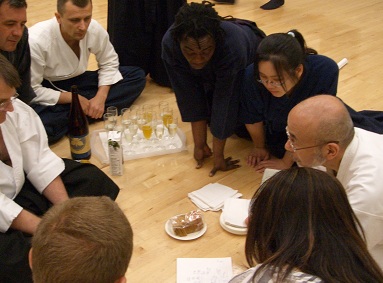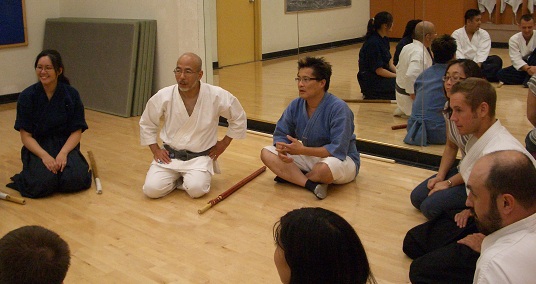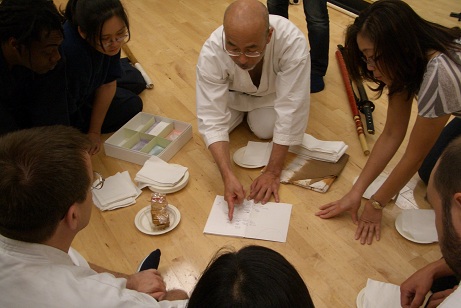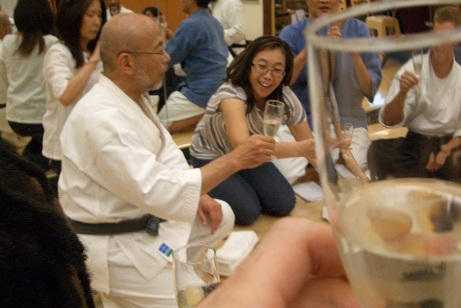This article is the 2nd part of a report on the seminar featuring Kajitsuka Sensei, soke of Yagyu Shingan Ryu Taijutsu.
Those interested in learning more about Kajitsuka Sensei can consult his group’s website: http://www.arakido.org/
The techniques we learned in both Kenjutsu and Jujutsu in the seminar were subtle and impactful, similar to Kajitsuka sensei’s personality and teaching style. It was definitely a truly memorable and eye opening experience. I wish to thank Kajitsuka sensei for his willingness to not only share the techniques of his style but for giving us the insight, the purpose, and meaning behind these techniques.
Joel A.
Markham, ON
I want to focus on two things that Joel had mentioned, namely that Kajitsuka Sensei’s personality was subtle and impactful. He is right. Kajitsuka Sensei is quiet and calm. He doesn’t speak loudly. He speaks quietly, sometimes softly. You have to listen very carefully and maybe that’s not a bad thing. You pay more attention.
Kajitsuka Sensei is also a philosopher, a thinker. When asked a question, Sensei would consider the question deeply before answering. He is deliberate and in no rush. In other words, he is very patient. And when he gives his answer, it is well thought out and in many cases, quite philosophical.
Kajitsuka Sensei is subtle; he is not in your face. There is no screaming, no shouting, no berating, or raising his voice. He doesn’t get worked up or frustrated. How can we encapsulate the essence of his teaching style in a word? I would say gentle.
What about his teaching method? Kajitsuka Sensei says only enough for you to get you to the next level of your development. He doesn’t give too much to overwhelm you. But he also is not deliberately trying to keep you down or keep things away from you. Joel talked about Sensei’s willingness to share. Yes, we covered a lot of kata. We received plenty of explanations, plenty of instruction (technical and philosophical). But it wasn’t about collecting kata or getting all the information we could. That would be impossible, and impossibly rude as well. But it was more Sensei’s openness and generosity that was so impressive.
Hello Mr. Tong,
I just wanted to thank you personally for the opportunity to be taught by Kajitsuka Soke. It was a great privilege and an even greater honour to have been taught so much and in such a personal way. It was a tremendous eye opening experience for me. The time and effort you and your family put forth was remarkable. I just wanted to thank you once again.
Domo arigato gozaimashita,
Patrick G.
Scarborough, ON
Patrick makes note of learning in such a personal way. Coincidentally, I asked Kajitsuka Sensei about the class atmosphere in koryu budo during lunch one day. He told me that in old days, it was one-to-one since the number of students was so small. The one-on-one style is basically a personalized approach to teaching. Teacher to student: heart-to-heart. We saw that in the seminar. He did techniques with each student one-on-one. We did mitori-geiko also. When they were working with partners, he made it a point to watch each pair deliberately and then offer some bit of personal advice to each student.

Teacher to student: heart to heart
I had remarked in Part 1:
After the seminar, we had a special ceremony where Kajitsuka Sensei presented each participant with a personalized shikishi, on which was written a saying, a piece of philosophy, or a principle from Yagyu Shingan Ryu or Yagyu Shinkage Ryu. He gave each participant some words to live by or some piece of philosophy to think deeply about, to guide them in their training or in their approach to budo and life in general. Each one was unique. The students were deeply touched by this personal gesture from Soke.
The personal touch was very evident. This was no 80-person seminar where you got lost in the shuffle, a situation in which one face blends into another. It was you and 9 other students and Sensei. He got to know each student. He practiced with each student. And, as the case of the shikishi indicates, he took a personal interest in each student.
At the end of the second day, we all sat down together after the seminar. This was a good chance to talk and ask Soke some questions about the two arts. It was an intimate setting.
The students found Soke very approachable. They asked him about the two styles. He talked about the history of the styles, the lineage and his place in it. The students also thought sensei was “down-to-earth”. He told us some funny stories about the times when he was a student under Mutoh Sensei. Old times, good times. Sensei was friendly and down-to-earth.

Post-seminar group discussion
It was an extraordinary experience to get to meet Kajitsuka Sensei. I was really blown away by his knowledge and understanding of both Yagyu Shingan Ryu and Yagyu Shinkage Ryu. But even more than that, I was blown away by his humility, passion, and love for his "Ryuha".
He is not just the "Soke", but a true teacher and we were really lucky to have him teach us for the two days that he spent with us.
Daniel C.
Woodbridge, ON
Daniel brought up some interesting issues. The first was the comment about Kajitsuka Sensei being a “true teacher”. I was puzzled so I later asked Daniel what he meant. He said that he felt Kajitsuka Sensei was a true teacher rather than one of those “ivory tower” teachers. The "ivory tower" headmasters and teachers are those that develop a big ego as a result of falling into the trap of thinking that they are somehow more special than everyone else. In his words, they come to believe that they are the enlightened ones as opposed to their students who are not. And this is what he meant when he sees them isolating themselves in their tower.
In contrast, Daniel told me:
“I just saw someone (Kajitsuka Sensei) come after a 22 hour flight (including a 10 hour stop-over), 2-3 hours sleep the night before, and have people literally throw him around all day long, and still spend the time with each student to make sure his teaching was well understood, and do so with extreme patience and understanding. That I think is the mark of a true teacher.”
For Daniel, that was a big lesson in what humility means in budo. Kajitsuka Sensei is also very humble. Sensei talks very quietly but as Joel said, it has an impact. Maybe that expression about silence being deafening has some truth to it.
More on humility, Sensei also didn’t talk about himself too much. He focused a lot on what Kamiizumi (the founder) thought, or what Muneyoshi said, or what Munenori wrote. He talked a lot about his own teachers, Mutoh Sensei and Ohtsubo Sensei, and their ideas, for example, like their reasoning behind the differences in technique between the branches, or the meanings of the various movements in the katas.

Soke talks to the group about the lineage of the style
When asked, what do you think of…? He would say, “well, Kamiizumi once said…” or “according to Munenori, …”. It was never about himself. He told a lot of stories about the Yagyu family, Kamiizumi Nobutsuna the founder, and others. In essence, he was telling us about the folklore and traditions of the style. He paid respect to the past and the ancestors of the style. It wasn’t about the technical stuff: how to cut, how to walk, etc… But the mystical stuff, the stories, the adventures. We got into an interesting talk about Yagyu Jubei and his eye-patch. The legend, the myth. We talked about Tokugawa Ieyasu and Yagyu Munenori, and their relationship. He told us about Kamiizumi and his meeting with Yagyu Muneyoshi (Sekishusai). Destiny. This was what turned a dry art into a living tradition. And that is what Daniel was referring to when he commented on Soke’s passion and love of his Ryuha. Not just sword-fighting, but to be a part of a living tradition, to be part of the myth, to be part of the legend. And it was evident from what Sensei said and alluded to, that he felt honoured to be a part of that tradition and to carry it on. And on our part, we felt deeply honoured and grateful that Kajitsuka Sensei would come all the way across the world to share his passion with us. It was truly a great and moving experience.

A toast and a big thank you to Kajitsuka Sensei for a wonderful seminar
For more information about hojojutsu, see these links:
http://en.wikipedia.org/wiki/Hoj%C5%8Djutsu
http://www.japaneseropeart.com/RopeArt/Hojojutsu/hojo_squaddie.html
Mr. Tong’s group can be found at: www.tokumeikan.org